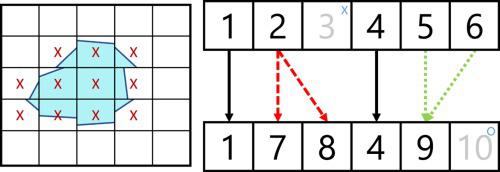Journal of Computational Physics ( IF 3.8 ) Pub Date : 2021-01-26 , DOI: 10.1016/j.jcp.2021.110156 Wai Hong Ronald Chan , Michael S. Dodd , Perry L. Johnson , Parviz Moin

|
Knowledge of bubble and drop size distributions in two-phase flows is important for characterizing a wide range of phenomena, including combustor ignition, sonar communication, and cloud formation. The physical mechanisms driving the background flow also drive the time evolution of these distributions. Accurate and robust identification and tracking algorithms for the dispersed phase are necessary to reliably measure this evolution and thereby quantify the underlying mechanisms in interface-resolving flow simulations. The identification of individual bubbles and drops traditionally relies on an algorithm used to identify connected regions. This traditional algorithm can be sensitive to the presence of spurious structures. A cost-effective refinement is proposed to maximize volume accuracy while minimizing the identification of spurious bubbles and drops. An accurate identification scheme is crucial for distinguishing bubble and drop pairs with large size ratios. The identified bubbles and drops need to be tracked in time to obtain breakup and coalescence statistics that characterize the evolution of the size distribution, including breakup and coalescence frequencies, and the probability distributions of parent and child bubble and drop sizes. An algorithm based on mass conservation is proposed to construct bubble and drop lineages using simulation snapshots that are not necessarily from consecutive time steps. These lineages are then used to detect breakup and coalescence events, and obtain the desired statistics. Accurate identification of large-size-ratio bubble and drop pairs enables accurate detection of breakup and coalescence events over a large size range. Accurate detection of successive breakup and coalescence events requires that the snapshot interval be an order of magnitude smaller than the characteristic breakup and coalescence times to capture these successive events while minimizing the identification of repeated confounding events. Together, these algorithms serve as a toolbox for detailed analysis of two-phase simulations, and enable insights into the mechanisms behind bubble and drop formation and evolution in flows of practical importance.
中文翻译:

识别和跟踪模拟中的气泡和液滴:用于获取大小,谱系以及破裂和合并统计信息的工具箱
了解两相流中的气泡和液滴尺寸分布对于表征各种现象(包括燃烧器着火,声纳通信和云形成)很重要。驱动背景流的物理机制也驱动这些分布的时间演变。为了可靠地测量这种演变并由此量化界面解析流模拟中的基本机制,必须对分散相使用准确而强大的识别和跟踪算法。传统上,对单个气泡和液滴的识别依赖于用于识别连接区域的算法。这种传统算法可能对虚假结构的存在敏感。提出了一种具有成本效益的改进方案,可最大程度地提高体积精度,同时最大程度减少对伪造气泡和液滴的识别。准确的识别方案对于区分大尺寸比率的气泡和液滴对至关重要。需要及时跟踪已识别的气泡和液滴,以获得破裂和合并统计数据,这些统计数据表征了大小分布的演变,包括破裂和合并频率,以及父子气泡和液滴大小的概率分布。提出了一种基于质量守恒的算法,该算法使用不一定来自连续时间步长的模拟快照来构造气泡和液滴谱系。然后将这些谱系用于检测分解和合并事件,并获得所需的统计信息。准确识别大比例气泡和液滴对可在大尺寸范围内准确检测破裂和聚结事件。准确检测连续破裂和合并事件需要快照间隔比特征破裂和合并时间小一个数量级,以捕获这些连续事件,同时最大程度地减少对重复混杂事件的识别。这些算法一起作为工具包,用于详细分析两阶段模拟,并使您能够洞察气泡和液滴形成背后的机制以及具有实际意义的流动演变。准确检测连续破裂和合并事件需要快照间隔比特征破裂和合并时间小一个数量级,以捕获这些连续事件,同时最大程度地减少对重复混杂事件的识别。这些算法一起作为工具包,用于详细分析两阶段模拟,并使您能够洞察气泡和液滴形成背后的机制以及具有实际意义的流动演变。准确检测连续破裂和合并事件需要快照间隔比特征破裂和合并时间小一个数量级,以捕获这些连续事件,同时最大程度地减少对重复混杂事件的识别。这些算法一起作为工具包,用于详细分析两阶段模拟,并使您能够洞察气泡和液滴形成背后的机制以及具有实际意义的流动演变。











































 京公网安备 11010802027423号
京公网安备 11010802027423号